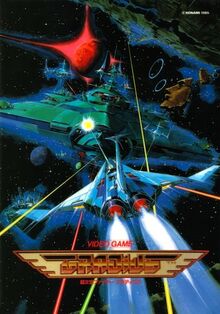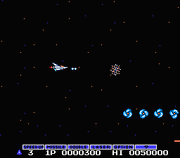
Gradius is a Horizontally Scrolling Shooter up released by Konami in 1985 for video Arcades. It was originally released in Japan and in Europe as Nemesis which was later rereleased as part of the Gradius Collection and Konami Classics Series: Arcade Hits. Gradius is the first game in the Gradius Series. Gradius has the distinction of popularizing a weapon selection bar called "Power meter", based upon collecting capsules to 'purchase' additional weapons. The game was ported to many systems, most notably the Nintendo Entertainment System (with this version also appearing on the Wii's Virtual Console).
Theres a different version of Nemesis for the MSX system which followed up with Nemesis 2 and Nemesis 3.

Description[]
The player controls the trans-dimensional spaceship Vic Viper, and must battle waves of enemies through various different environments.
The game became synonymous with the phrase, "Shoot the core!", as the standard of boss battles in the Gradius series involved combat with a giant craft, in the center of which would be situated one to several blue colored spheres. These bosses would be designed in such a way that there would be a straight passage from the exterior of the giant craft which leads directly to one of these cores. The player must fire shots into this passage whilst avoiding attack patterns from weapon emplacements on the body of the boss. However, small but destructible walls are situated in this passage, impeding the bullet shots from damaging the core, and must be whittled away by repeated well-placed shots. In a way, these tiny walls represent the boss' shielding gauge until its core is finally vulnerable to attack. Some bosses have the ability to regenerate these walls. When the core has sustained enough hits, it usually changes color from blue to red, indicating that it is in critical condition and its destruction is imminent. Upon the destruction of a core, a piece of the boss may be put out of commission, seeing that it is no longer powered by a core, or if all of the cores are destroyed, the entire boss is defeated and explodes satisfyingly. Note that these cores are not present on the more organic bosses of Gradius. Such bosses have weak spots in places such as a mouth, head or eye.
The name "Gradius" refers to the human-inhabited planet in which the Vic Viper is from (also known as planet Nemesis), and not a mistranslation of the word "gladius" (cf. Engrish) as one might assume.
Weapon system[]
When gameplay begins, the Vic Viper is relatively slow and has only a weak gun. This level of capability is generally insufficient for engaging enemies, but the Vic Viper can gain greater capabilities by collecting and using power-up items.
While most arcade games utilize distinct power up-items that each correspond to a specific effect on the player character, Gradius has a single power-up item. The effect of this power-up item is to advance the currently selected item in a power-up menu that appears at the bottom of the screen. When the desired power-up is highlighted, the player can obtain it by pressing the power-up button, returning the menu to its initial state in which no power-up is highlighted.
Konami Code[]
Home console and portable versions of Gradius spawned the now-legendary Konami Code, considered by some to be one of the defining elements of Gradius. The code, when entered while the game is paused, grants the player most of the available power ups.
Ports[]
Ports of Gradius were also done for the Commodore 64, Microsoft Windows, NEC PC-8801, MSX, NES, TurboGrafx-16, Virtual Console, Sharp X1, Sharp X68000, Mobile Phone, Playstation 2 and Sinclair ZX Spectrum.
The TurboGrafx-16 port is Arcade identical but also adds bonus stages.
Gradius was also converted for the Nintendo Vs. Series arcade platform. It is identical to the NES version, but includes no cheat codes and allows the player to continue indefinitely.
A light open source clone called Monadius was completed in 2005 implemented in Haskell (programming language) using OpenGL.
See also[]
